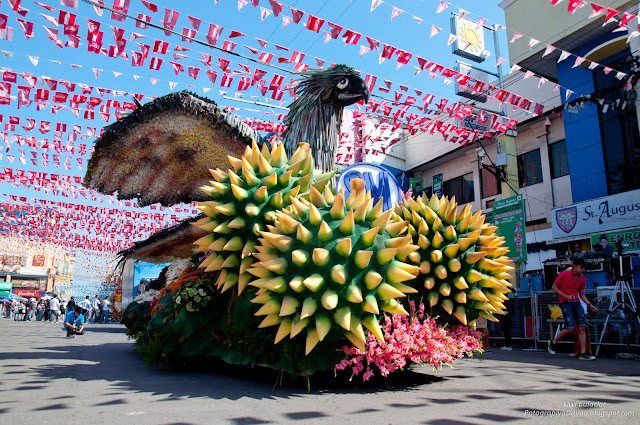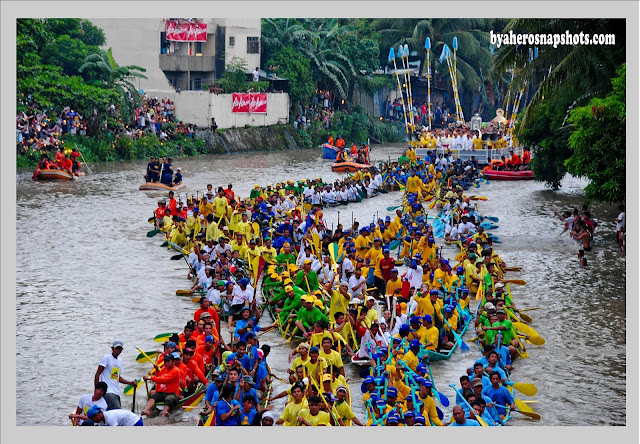- Feast of the Black Nazarene (January 9th/Quiapo Manila)
The Black Nazarene (Poong Itim na Nazareno in Tagalog) is a life-sized, dark wooden sculpture of Jesus Christ carrying the cross. Devotees ranges from hundreds to thousands who joins the procession while yelling "Viva Señor!", believes that the patron saint is miraculous.
- Sinulog Festival (3rd week of January/Cebu City)
The word Sinulog comes from the Cebuano adverb sulog meaning "like water current movement", it describes the forward-backward movement of the Sinulog dance. This is the local version of Mardi Gras as they celebrate their patron saint, the Santo Niño (Santo Niño is a Spanish word for "Holy Child"). The celebration lasted for nine days and had been promoted for tourist attraction.
- Ati-Atihan Festival (3rd Sunday of January/Kalibo,Aklan)
The word "Ati-Atihan" means "to be like Aetas" or "make belive Ati's". It was believed that the primary settlers of the islands were the Aetas. Ati-Atihan feast was held annually in honor of the Santo Niño, like the Sinulog Festival. The festival starts with a mass and begins with the rhythmic drumbeats and dances along the streets as they wear their tribal clothing with a blackface and body to imitate the aboriginal Ati while shouting, "Hala Bira! Pwera Pasma!" as they believe that Santo Niño will protect them from harm and illness.
- Dinagyang Festival (4th weekend of January/Iloilo City)
Dinagyang festival was held just after the Sinulog and Ati-atihan festival, all in honor of the Santo Niño held in Iloilo. From the promotional sketches made from 2002 the caricature was later adopted as the official logo and named Dagoy, which is now the official mascot of Dinagyang. The Ilonggos showcase their rich culture, history and devotion in honor of the Santo Niño. Everyday clothes were changed to Ati warrior costumes and black body paint all for the patron saint.
FEBRUARY FIESTA
- Panagbenga Festival (whole month of February to March 4/Baguio City)
If you want to go out from the busy street in the city and escape from the hot weather in the metro visit the month-long annual flower festival in Baguio City, the Panagbenga "Flower" Festival which is held during the month of February. It was created as a tribute to the city's flowers and as a way to rise up from the devastation of the 1990 Luzon earthquake. The festival includes street dancing, dancers with flower costumes and the much awaited floats decorated with different varieties of flowers.
MARCH FIESTA
- Moriones Festival (April 18-24/Marinduque)
The province of Marinduque celebrates the Lent with a twist and colorful way. Morion means "mask" or "visor" while Moriones refers to the masked and costumed penitents who march around the town for seven days searching for Longinus. This festival re-enacts the story of Saint Longinus, a Roman centurion who was blind in one eye. Actors were wearing colorful Roman costume with painted mask and helmets.
APRIL FIESTA
- Manaoag Pilgrimage (2nd week of April/Pangasinan)
The Our Lady of the Rosary of Manaoag is the patroness of the town of Pangasinan. An ivory image of the Blessed Virgin Mary from the 17th century is now at the altar of Pangasinan. It is yearly celebrated as the devotees believed that the image was miraculous and possesses healing powers as the
patroness of the sick.
MAY FIESTA
- Flores de Mayo (whole month of May/Nationwide)
The Flores de Mayo ("Flowers of May") is celebrated the whole month of May in honor of the Virgin Mary.
Santacruzan or Sagala is a beauty pageant tradition held in every town, cities and barangays where young women is escorted by a young men having a procession which commemorates the search of the Holy Cross by Reyna Elena and her son, the newly-converted emperor Constantine.
- Pulilan Carabao Festival (May 15-16/Pulilan, Bulacan)
Have you seen a kneeling Carabao or water buffalo? Why not visit the Pulilan Carabao Festival. Carabao's usually seen only in the farm helping our farmers till their land, but here in Pulilan, carabao's are beautifully decorated with a variety of colors, flowers, fruits, vegetables and other food crops that were hung in the bamboo poles and carts. These carts were pulled by the carabao's and served as their float. The farmer's lead their carabao's for the annual procession were carabao's need to kneel and walk on their knees in front of the church to pay tribute to their patron saint San Isidro Labrador (St. Isidore the Laborer) . This is celebrated as a thanksgiving for a year-long bountiful harvest.
- Pahiyas Festival (May 15/Lucban,Quezon)
If Pulilan Bulacan have their Carabao Festival, Lucban Quezon have their Pahiyas Festival both in honor of the patron saint San Isidro Labrador or St. Isidore the Laborer. If the Bulakenyo (people living in Bulacan) adorn their carabao's, in Lucban people adorn their houses with variety of fruits, vegetables, agricultural products, handicrafts and their famous
kiping (a rice-made decoration, which afterwards can be eaten, grilled or fried). These decorative houses were judged and the best one will be declared as the winner. Tourist visits Lucban yearly to witness how these houses were beautifully decorated.
- Obando Fertility Rites (May 17-19/Obando, Bulacan)
If a couple wishes and pray to bear a child, have a husband or a wife and have a good fortune, the place to go to is at Obando Bulacan. The festivity will last for 3 days as they dance on the streets while wearing the traditional dance costumes and singing the song "Santa Clara Pinung-pino",believing that their prayers will be heard and the spirit will give their wishes, the procession is followed by the image of the three saints namely: San Pascual Baylon (St. Paschal), Santa Clara (St. Claire) and Nuestra Señora de Salambao (Our Lady of Salambao).
JUNE FIESTA
- Parada ng Lechon Festival (June 24/Balayan,Batangas)
Simply hearing this parade makes me hungry... =) The Lechon or Roasted Pig is a festival food for Filipinos. This dish is cooked by skewering the whole pig, entrails removed and cooking it in a pit filled with charcoal while continuously rotating it until it gets reddish in color and crispy. It takes hours to cook, but when its cooked, long wait and hard work pays-off on how savory it is. But people in Balayan don't just eat it right away. They dress up their Lechon with curly wigs, fancy dresses, sunglasses, veil, suits or anything that they want their Lechon to look like and parade it in town before eating it. This festival is in honor of the patron saint, San Juan or St John the Baptist.
- Pintados-Kasadyaan Festival (June 29/Tacloban,Leyte)
The Pintados Festival shows the rich cultural heritage of the people from Samar and Leyte while showing their native dances and music. The dancers are dressed like an ancient tatooed "pintados" warriors, showing their Pre-Spanish history and to let us know how our Philippine ancestors lived. This festivity is in honor of the patron saint Sr. Santo Niño.
JULY FIESTA
- Bocaue River Festival (1st Sunday of July)
The Bocaue came from the tagalog word
Bokawe which refers to a type of long bamboo. The Bocaue River Festival is also known as Bocaue Pagoda Festival, Pagoda sa Wawa and Pista ng Mapagpalang Krus sa Wawa (Fiesta of the Blessed Cross of Wawa). The festival is celebrated in honor of the Holy Cross of Wawa (Mahal na Krus sa Wawa). The festival is known from its fluvial procession, while devotees douse each other with water. The boat is colorfully decorated and adorned, small vessels also joins to take part in the procession and others just decided to swim near the vessel just to honor the patron saint.
AUGUST FIESTA
- Davao's Kadayawan Festival (3rd week of August/Davao City)
Davao's Kadayawan Festival (Kadayawan sa Dabaw) is one of the popularly celebrated festival in the Philippines also called as the
festival of festivals and the
king of festivals. The festivities start with street dancing showing their tribal dance and costumes with the music "Indak-Indak sa Kadalanan" followed by other events like beauty contest, fruit and flower shows, colorful floats, Lumadnong Kasaulogan (Indigenous People Festival) and Subay sa Lumadnong Kagikan (Contemporary Indigenous-motivated Celebrations). The Davao's Kadayawan Festival is celebrated to give thanks to their bountiful harvest of fruits and orchids.
SEPTEMBER FIESTA
- Peñafrancia Festival (3rd Saturday and Sunday of Sept./Naga City,Bicol)
The Peñafrancia Festival or the Feast of Nuestra Señora de Peñafrancia is a nine day festivities as tourist and devotees come to Naga City to honor the patroness, Our Lady of Peñafrancia (Nuestra Señora de Peñafrancia), a wooden statue of the Blessed Virgin Mary. The highlights of the festival is the fluvial procession where the image is carried in the pagoda by the Bicolano's going back to its basilica, as they shout "Viva La Virgen!" followed by a mass.
OCTOBER FIESTA
- Masskara Festival (3rd week of October/Bacolod City)
Masskara is a fusion of English word "mass" which means
many, Spanish word "cara" which means
face and Tagalog word "maskara" meaning
mask. It's a celebration of many people wearing colorful mask on their face which is always adorned with a beautiful smile as the expression of thanks for the abundance of blessings life brought to them. As they celebrate it with street dance, parades, beauty contest and other events that people and tourist love about.
NOVEMBER FIESTA
- Higantes Festival (November 22-23/Angono,Rizal)
The Higantes (Giants) is made up of paper-mache and measures four to five feet in diameter and ten to twelve feet in height which was influenced by the Mexican art form brought by the Spanish priests to the Philippines. This is celebrated in honor of the patron saint, St. Clement or San Clemente. The procession is joined by the pahedoras, group of young girls holding paddles and wearing bakya(wooden slippers) and dressed colorfully. The Pahedora serves as a reminder that Angono was once a fishing village and thrives at the harvest of Laguna Lake.
DECEMBER FIESTA
- Giant Lantern Festival (December19/SanFernando,Pampanga)
Christmas, is that your favorite season? For me, Christmas season is what I'm really looking forward to. It's a family christmas tradition to decor our houses with simple handmade christmas ornaments like
Parol or
Lantern, artifial christmas trees and outdoor string lights or outdoor christmas lights and giving each other on christmas eve a nativity christmas cards. But in San Fernando Pampanga, christmas was made colorful with their annual Parol Festival, displaying their unique christmas lanterns. Because of the famous Parol or Giant Lantern competition the San Fernando Pampanga was called the "Christmas Capital of the Philippines".



.jpg)


















0 comments:
Post a Comment